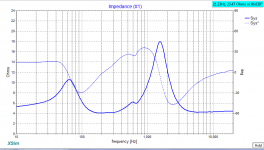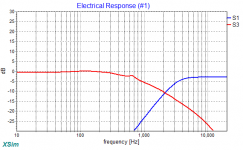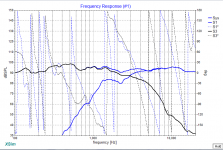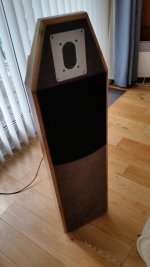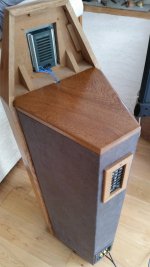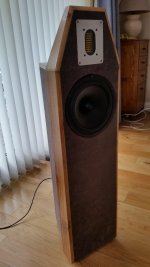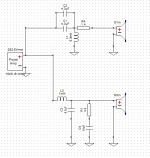Anyone with experience of the sound of live instruments should be able to tell that Jordans are the most natural sounding speakers available. I've been both a musician and a piano tuner at different times, and also designed electrostatics for a few years. Electrostatics have numerous problems, not the least of which is low efficiency. Imaging is also difficult due to their size. Love their low distortion but can't live with them. I sold mine 10 years ago.
I think the Zaph drivers would make a good cheap surround system. If that spike can be tamed they would be very pleasant, and the price is brilliant.
I think the Zaph drivers would make a good cheap surround system. If that spike can be tamed they would be very pleasant, and the price is brilliant.
Last edited:
I've attached harmonic distortion plots of this design and my Griffin mini-monitors which also use the Aurum Cantus ribbon but with the smaller JX92 unit. Crossover point on the mini monitors is 3000Hz vs around 3500Hz on the larger JX150ng design. Both were made without mic calibration but using the same set up and show frequency response curves tracking each other very closely.
The JX150ng distortion, shown in green on the attached, appears to hold up very well against the JX92 with only marginally higher 3rd harmonic and much lower 2nd harmonic. Not bad, given the high X-over point, possibly endorsement for the design of the larger unit's cone profile.
Given that the tweeters are identical the much lower THD above 2500Hz in the JX150ng design was unexpected but I wonder if this might be due to the steeper JX150ng X-over roll-off and correspondingly less overlap and/or the much smaller baffle width of 4.5" in the JX150ng design vs 7" on the mini monitors.
Attachments - THD, 2nd harm. 3rd harm.
The JX150ng distortion, shown in green on the attached, appears to hold up very well against the JX92 with only marginally higher 3rd harmonic and much lower 2nd harmonic. Not bad, given the high X-over point, possibly endorsement for the design of the larger unit's cone profile.
Given that the tweeters are identical the much lower THD above 2500Hz in the JX150ng design was unexpected but I wonder if this might be due to the steeper JX150ng X-over roll-off and correspondingly less overlap and/or the much smaller baffle width of 4.5" in the JX150ng design vs 7" on the mini monitors.
Attachments - THD, 2nd harm. 3rd harm.
Attachments
Last edited:
They both look very respectable from here. I agree, the sharper cutoff may be the decider for the JX150 design. I'd expect ribbons to have a better distortion figure than a piston.
I have reworked these. Drive units are now Seas U22 (early 4 ohm version) with aperiodic vent
and Mundorf AMD 2430 on an open baffle. There remain a few cosmetic jobs to be done such as a trim around the recessed Seas woofer which has a smaller chassis than the Jordan it replaces, and rear tweeter grille.
The aim with the vent is to allow as much sound as possible (within reason) to escape from the enclosure to match the rear radiation of the AMT tweeter and to that end the path directly between the driver and the vent is clear of box stuffing.
I have attached a few graphs etc. The response below around 500Hz is probably not accurate and is likely due to measurement conditions. In any case there are separate subwoofers in the room to fill out the bass.
Soundwise, there's an addictive sense of space and perspective. Treble is silky smooth, extremely open and clean and the Seas U22 seems very neutral too with clean midrange. Its revealing to damp the rear tweeter response with cushions placed behind, this results in a darker top end with reduced sense of space, so they are certainly staying open.
and Mundorf AMD 2430 on an open baffle. There remain a few cosmetic jobs to be done such as a trim around the recessed Seas woofer which has a smaller chassis than the Jordan it replaces, and rear tweeter grille.
The aim with the vent is to allow as much sound as possible (within reason) to escape from the enclosure to match the rear radiation of the AMT tweeter and to that end the path directly between the driver and the vent is clear of box stuffing.
I have attached a few graphs etc. The response below around 500Hz is probably not accurate and is likely due to measurement conditions. In any case there are separate subwoofers in the room to fill out the bass.
Soundwise, there's an addictive sense of space and perspective. Treble is silky smooth, extremely open and clean and the Seas U22 seems very neutral too with clean midrange. Its revealing to damp the rear tweeter response with cushions placed behind, this results in a darker top end with reduced sense of space, so they are certainly staying open.
Attachments
"Soundwise, there's an addictive sense of space and perspective."
Yes, there's an irony that dipoles make better stereo than point-source speakers. I think the basic error is thinking recording engineers can package the sound so perfectly that a point-source can unfold it into the room.
(Might sound even better with stuffing in the cabinet and with the back off.)
Nice work.
B.
Yes, there's an irony that dipoles make better stereo than point-source speakers. I think the basic error is thinking recording engineers can package the sound so perfectly that a point-source can unfold it into the room.
(Might sound even better with stuffing in the cabinet and with the back off.)
Nice work.
B.
'Might sound even better with stuffing in the cabinet and with the back off.'
Yes, that's a thought, though I think I'm already pushing the limits using minimal aperiodic loading of these particularly low Qts woofers. They're around 0.23 so I consider it fortunate that I have the bass that I have.
Yes, that's a thought, though I think I'm already pushing the limits using minimal aperiodic loading of these particularly low Qts woofers. They're around 0.23 so I consider it fortunate that I have the bass that I have.
Sure would be a service to all readers if you took your screwdriver* and....
(after making careful "before" measurements, taping your mic stand to the floor, and just grab a few pillows to lightly stuff into the box with the back off)
B.
(after making careful "before" measurements, taping your mic stand to the floor, and just grab a few pillows to lightly stuff into the box with the back off)
B.
Last edited:
- Home
- Loudspeakers
- Multi-Way
- New Jordan JX150/A.C.Ribbon Design



